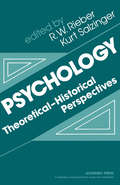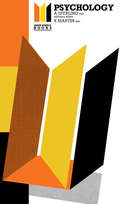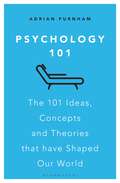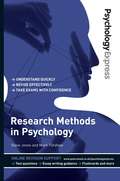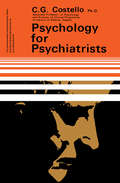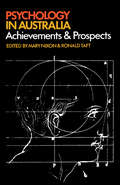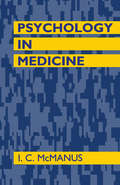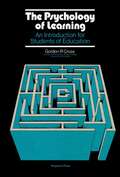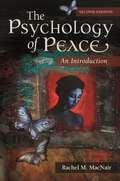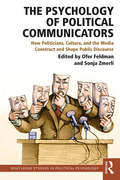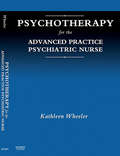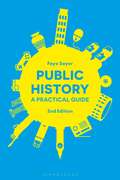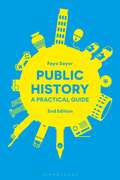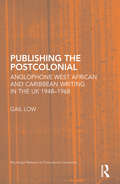- Table View
- List View
Psychological Studies of Science and Technology (Palgrave Studies in the Theory and History of Psychology)
by Lisa M. Osbeck Ernst Schraube Kieran C. O’Doherty Jeffery YenThis book provides a significant contribution to scholarship on the psychology of science and the psychology of technology by showcasing a range of theory and research distinguished as psychological studies of science and technology. Science and technology are central to almost all domains of human activity, for which reason they are the focus of subdisciplines such as philosophy of science, philosophy of technology, sociology of knowledge, and history of science and technology. To date, psychology has been marginal in this space and limited to relatively narrow epistemological orientations. By explicitly embracing pluralism and an international approach, this book offers new perspectives and directions for psychological contributions. The book brings together leading theorists and researchers from around the world and spans scholarship across a variety of traditions that include theoretical psychology, critical psychology, feminist psychology and social constructionist approaches. Following a historical and conceptual introduction, the collection is divided into three sections: Scoping a New Psychology of Science and Technology, Applying Psychological Concepts to the Study of Science and Technology and Critical Perspectives on Psychology as a Science. The book will interest interdisciplinary scholars who work in the space of Science and Technology Studies and psychologists interested in the diverse human aspects of science and technology.
Psychology: Theoretical–Historical Perspectives
by R. W. Rieber Kurt SalzingerPsychology: Theoretical-Historical Perspectives offers analysis, provided by different contributors, of the theoretical traditions in psychology. The compilation provides articles that discuss topics on the influences in the development of American psychology; the development of the concept of the self in psychology; the groundwork for psychology before the Civil War; and the influence of Darwin's evolutionary theories on psychology. Psychologists and students will find the book invaluable.
Psychology: Made Simple
by Abraham P. SperlingPsychology: Made Simple covers the development of psychology over the years and the basic psychological knowledge. The book describes the scientific approach to the study of the human nature, the physiological aspects of psychology, perception, and the processes of learning. The text also discusses John Dewey’s analysis of reasoning; creativity, logic, critical thinking, and divergent and convergent thinking; the nature of thinking; and the relationship between thinking and language. The process of remembering; intelligence and aptitudes and tests used to measure both; the basis of individual differences; and the psychology of infancy, childhood, and adolescence are also considered. The book tackles the theories of emotions and personality development, the role of motivation in personality development; personality adjustment and maladjustment; and the neurotic and abnormal personalities. Issues in social psychology are considered as well. Students taking psychology, social sciences and education will find the book invaluable.
Psychology 101: The 101 Ideas, Concepts and Theories that Have Shaped Our World
by Adrian FurnhamPsychologists have always shone a torch, and often a spotlight, into many dark corners of the human mind. They study everything, from art preferences to altruism, coaching to criminality, jokes and humour to justice and honesty, as well as sex differences, schizophrenia and sociopathy.Psychology can offer clear descriptions and explanations for all sort of phenomena. More importantly, psychological research can improve lives in a multitude of ways; many applied psychologists - e.g. clinical, educational, counselling and work psychologists – have the primary aim of making people more happy and better able to identify and realise their full potential.Psychology 101 offers bite-size articles of psychological science from Adrian Furnham, a seasoned psychologist with a broad range of expertise. This book is the essential guide for anyone with an interest - either academic, professional or general - in demystifying and understanding the fascinating world of psychological history, theories, issues and beliefs.
Psychology 101: The 101 Ideas, Concepts and Theories that Have Shaped Our World
by Adrian FurnhamPsychologists have always shone a torch, and often a spotlight, into many dark corners of the human mind. They study everything, from art preferences to altruism, coaching to criminality, jokes and humour to justice and honesty, as well as sex differences, schizophrenia and sociopathy.Psychology can offer clear descriptions and explanations for all sort of phenomena. More importantly, psychological research can improve lives in a multitude of ways; many applied psychologists - e.g. clinical, educational, counselling and work psychologists – have the primary aim of making people more happy and better able to identify and realise their full potential.Psychology 101 offers bite-size articles of psychological science from Adrian Furnham, a seasoned psychologist with a broad range of expertise. This book is the essential guide for anyone with an interest - either academic, professional or general - in demystifying and understanding the fascinating world of psychological history, theories, issues and beliefs.
Psychology Express: Research Methods in Psychology
by Steve Jones Mark Forshaw Dominic UptonThis revision guide provides concise coverage of the central topics within Research Methods in Psychology, presented within a framework designed to help you focus on assessment and exams. The text encapsulates all the subject matter listed in the BPS Qualifying Examination syllabus for the area. The structure of the book represents a logical, linear progress through your typical learning in relation to Research Methods in Psychology. The two authors bring their clear, accessible style to bear on this, making the normally 'dry' subject matter seem more lively and engaging. The chapter on writing reports is deliberately left to the end since this is the natural culmination of your research process. Sample questions, assessment advice and exam tips drive the organisation within chapters so you are able to grasp and marshal your thoughts towards revision of the main topics. Features focused on critical thinking, practical applications and key research will offer additional pointers for you in your revision process and exam preparation. A companion website provides supporting resources for self testing, exam practice, answers to questions in the book, and links to further resources.
Psychology for Psychiatrists
by C. G. CostelloPsychology for Psychiatrists covers the aspects of psychology that would be of interest and value to the psychiatrist. This book is composed of 19 chapters, and begins with discussions on the basic research concepts of descriptive statistics, reliability and validity, and drugs research design. The succeeding chapters consider the problems in clinical psychology, including test of thought disorder, organicity, projective techniques, and questionnaires and rating scales. These tests will enable the psychiatrist to better evaluate the received information from clinical psychologists. Other chapters describe the methods and concepts that the clinical psychiatrist may find immediate value in the work. The concluding chapters explore the areas of study that are probably of primary interest to the research psychiatrist and to which they have also contributed. These areas include sleep, hypnosis, and sensory and emotional deprivation. This book is of value to psychologist, and research and clinical psychiatrists.
Psychology in Australia: Achievements & Prospects
by Mary Nixon Ronald TaftPsychology in Australia: Achievements & Prospects is an assessment of the achievements and prospects of the field of psychology in Australia. Issues related to teaching and research are examined, and research areas that are flourishing, as well as those that are floundering or neglected, are highlighted. The main emphasis is on fields of endeavor in which psychology is applied to individual, social, and organizational issues. This book is comprised of 22 chapters and begins with an introduction to the first phases of teaching and practice of psychology in Australia, followed by a historical overview of applied psychology in the country. Subsequent chapters explore the influence of culture on Australian psychology; psychological research in universities and colleges, in clinical and counseling psychology, and in health education; and the training and education of psychologists in Australia. Some applications of psychology are also discussed, along with private practice in Australian psychology. The final chapter focuses on Australian psychologists in the world context. This monograph should be of interest to students and general readers as well as to psychologists themselves.
Psychology in Contemporary China
by L. B. BrownPsychology in Contemporary China focuses on the advancement of psychology in China and the different areas to which this field is applied. The book proceeds by outlining the evolution, nature, and characteristics of Chinese psychology. The text then points out that studies on this discipline is generally difficult, because of the lack of publication of resources in English. The process of learning this field is often done through visitations, with specialists going to China to conduct research and lectures. The text investigates the evolution of psychology in China, as well as its progress through education. The relationship of this discipline with political and social concerns is highlighted, and the progress of this field in universities in China is emphasized. The practice of psychology in China is somewhat limited. This lack is expressed by the fact that psychologists avoid questions that have political content. An examination of the attitudes of Chinese is also presented, and their views on individuality, self-criticism, violence, child-rearing, religion, and modernization are discussed. The book is of great importance for scholars and readers who research on the evolution, growth, and contributions of psychology to society.
Psychology in Medicine
by I.C. McManusPsychology in Medicine focuses on the academic and applied discipline that involves the scientific study of mental functions and behaviors. This book stresses that the method of study known as surface learning, with its emphasis on rote-learning, will not work well in studying the behavioral sciences. Instead deep learning, with its emphasis on ideas and principles, is required. This text discusses the basic processes of psychology and general applications of psychology to medicine. Other topics include child development, Freud and emotional development, personal construct theory, and doctor-patient communication. The models of mental illness, neuropsychology, and mental retardation are also described. This publication is intended for psychologists, medical practitioners, and students researching on psychology and its factors.
Psychology In A Week: Teach Yourself (In A Week)
by Nicky HayesLearn in a week, remember for a lifetime!In just one week, this accessible book will give you knowledge to last forever. End of chapter summaries and multiple choice questions are all designed to help you test your knowledge and gain confidence. So whether you are a student or you simply want to widen your knowledge, you will find this seven-day course a very memorable introduction.Sunday: Learn how humans grow up in and adapt to a social environmentMonday: Discover what emotions are and what affects our state of mindTuesday: Consider why we are motivated to do what we doWednesday: Discover the Buddhist scriptures and learn how they are interpreted today.Thursday: Engage with evolutionary psychology and the role of genes. Think about what intelligence is and how it comes about.Friday: Discover the factors influencing the psychological development of children, adolescents and adults.Saturday: Explore what psychologists do and how
Psychology of Communication
by Jessica Röhner Astrid SchützThis successful textbook on the psychology of communication explains - here in English for the first time - how human communication works in a very understandable way. It begins with the explanation of central terms and the explanation of known communication models (e.g. the models according to Schulz von Thun, Watzlawick, Hargie and colleagues), then describes means of non-verbal and verbal communication and ends with a clear and structured summary of communication forms. Concrete fields of application, stumbling blocks (e.g. intercultural differences in communication), practical examples and digressions in the book round off what has been read and consolidate what has been learned. In addition, free learning materials are available on the Internet with which readers can test their knowledge acquisition.
The Psychology of Learning: An Introduction for Students of Education
by Gordon R. CrossThe Psychology of Learning: An Introduction for Students of Education underlines some of the practical implications of the classical and more traditional topics of study, as well as the theoretical models of learning and psycholinguistics. The book explores various aspects of learning, including memory, motivation, skills, language, thinking, problem-solving, intelligence, ability, personality, educational technology, and moral behavior. The topics discussed in this book will be very valuable for all teachers in training.
The Psychology of Peace: An Introduction
by Rachel M. MacNairDespite our advances in technology and education, we still live in a world permeated by violence. This introductory textbook in the field of peace psychology addresses the psychological causes of violence and nonviolence, conflict resolution, nonviolent struggle, and the confluence of public policy and private lifestyles.Just as health providers study disease and its prevention, understanding the causes of violent behavior and how to prevent such behavior is a basic cornerstone for those who are working towards a healthy society. Another parallel: maintaining physical health involves positive practices; similarly, positive nonviolent approaches need to be psychologically understood and encouraged. The second edition of The Psychology of Peace: An Introduction demonstrates what can be learned through the lens of peace psychology, providing a solid foundation in the psychological theories needed for building and maintaining a peaceful society and peaceful individuals.This second edition incorporates the tremendous amount of new research and subsequent events since 2003, including post-2003 violent and nonviolent revolutions, such as the ongoing war in Iraq and Afghanistan, and the nonviolent overthrowing of dictators in Tunisia and Egypt. Author MacNair again outlines why application of psychological study to the soundness of decision-making for public policy—and to the policies themselves—is crucial knowledge, and how applying the study to private practices and even art can help build up a peaceful society.
The Psychology of Political Communicators: How Politicians, Culture, and the Media Construct and Shape Public Discourse (Routledge Studies in Political Psychology)
by Ofer Feldman Sonja ZmerliIn this timely study, Ofer Feldman, Sonja Zmerli, and their team of experts shed light on the multiple ways communication affects political behavior and attitudes. Written for students and scholars alike, The Psychology of Political Communicators uses examples from the US, Europe, Asia, and the Middle East to examine the nature, characteristics, content, and reception of communication in three major areas of discourse: The style and nature of language used by political actors in the national and international arenas The discourse used in nationalist populist movements and during negative campaigns The rhetoric of the media as it tries to frame politics, political events, and political actors Collectively, the essays form a solid foundation on which to understand the different roles language plays in the conduct of politics, the way in which these roles are performed in various situations in different societies and cultures, and the political outcomes of verbal behavior. This book will be of interest to scholars and students of political psychology and communication studies.
The Psychology of Political Communicators: How Politicians, Culture, and the Media Construct and Shape Public Discourse (Routledge Studies in Political Psychology)
by Ofer Feldman Sonja ZmerliIn this timely study, Ofer Feldman, Sonja Zmerli, and their team of experts shed light on the multiple ways communication affects political behavior and attitudes. Written for students and scholars alike, The Psychology of Political Communicators uses examples from the US, Europe, Asia, and the Middle East to examine the nature, characteristics, content, and reception of communication in three major areas of discourse: The style and nature of language used by political actors in the national and international arenas The discourse used in nationalist populist movements and during negative campaigns The rhetoric of the media as it tries to frame politics, political events, and political actors Collectively, the essays form a solid foundation on which to understand the different roles language plays in the conduct of politics, the way in which these roles are performed in various situations in different societies and cultures, and the political outcomes of verbal behavior. This book will be of interest to scholars and students of political psychology and communication studies.
Psychotherapy for the Advanced Practice Psychiatric Nurse - E-Book
by Kathleen WheelerPsychotherapy for the Advanced Practice Psychiatric Nurse provides the nurse psychotherapist with a useful “how-to" primer that contains practical techniques and interventions without a lot of theoretical jargon. Topics include the basics of psychotherapy, from how to respond to a patient’s initial call to termination of care. Selected approaches, interpersonal, cognitive-behavioral, and psychodynamic psychotherapy are highlighted with discussion of evidence-base research. Specific techniques for working with commonly seen patient populations that require special consideration: those who have experienced trauma, children, and older adults are included. In addition, how to integrate psychopharmacology and psychotherapy is discussed in detail.A straightforward approach to psychotherapy using a holistic nursing framework. Latest findings on the neurophysiology of psychotherapy including research on attachment, therapeutic relationships, and trauma. Evidence-based research for all approaches and populations discussed. Provides treatment hierarchy for decision making in selecting strategies for treatment from the initial contact and assessment to termination.Step-by-step guide to building the nurse-patient relationship in order to achieve quality outcomes. Includes detailed instructions on therapeutic communication techniques.Detailed instructions teach you how to use the latest therapeutic communication techniques.Includes all patient populations from children to the older adult with special emphasis on working with traumatized patients.Comprehensive appendices provide quick access to helpful forms and diagnostic tools specific to psychotherapy nursing practice.
Public Debt and the Common Good: Philosophical and Institutional Implications of Fiscal Imbalance (Routledge Research in American Politics and Governance)
by James OdomThe American national debt stands at $20.49 trillion as of January 2018, or roughly $63,000 for every person in the United States. The national debt has grown six-fold in the past 25 years, and borrowing only has accelerated in recent administrations. What are the factors driving such unrestrained borrowing? Is American fiscal policy different now than in an earlier era? Is there a moral dimension to public debt and, if so, how can that dimension be measured? Public Debt and the Common Good addresses these and other questions by looking to the fiscal policy of the American states. Drawing on classical themes and the longest quantitative review of state debt in the literature, James Odom expertly integrates institutional analysis with dimensions of culture to define the parameters of political freedom in a theoretically coherent way. In doing so, Odom argues that centralization and injustice, or the incapacity for the common good, can help explain state indebtedness. Contributing to ongoing scholarly debates on public debt theory, this book will be of interest to students, scholars, and practitioners who work at the intersection of political philosophy and economics, as well as those who specialize in state public policy, state politics, and federalism more generally.
Public Debt and the Common Good: Philosophical and Institutional Implications of Fiscal Imbalance (Routledge Research in American Politics and Governance)
by James OdomThe American national debt stands at $20.49 trillion as of January 2018, or roughly $63,000 for every person in the United States. The national debt has grown six-fold in the past 25 years, and borrowing only has accelerated in recent administrations. What are the factors driving such unrestrained borrowing? Is American fiscal policy different now than in an earlier era? Is there a moral dimension to public debt and, if so, how can that dimension be measured? Public Debt and the Common Good addresses these and other questions by looking to the fiscal policy of the American states. Drawing on classical themes and the longest quantitative review of state debt in the literature, James Odom expertly integrates institutional analysis with dimensions of culture to define the parameters of political freedom in a theoretically coherent way. In doing so, Odom argues that centralization and injustice, or the incapacity for the common good, can help explain state indebtedness. Contributing to ongoing scholarly debates on public debt theory, this book will be of interest to students, scholars, and practitioners who work at the intersection of political philosophy and economics, as well as those who specialize in state public policy, state politics, and federalism more generally.
Public History: A Practical Guide
by Faye SayerThe 2nd edition of Public History: A Practical Guide provides a fresh examination of history as practiced in its various worldly guises and contexts. It analyses the many skills that historians require in the practice of public history and looks at how a range of actors, including museums, archives, government agencies, community history societies and the media/digital media, make history accessible to a wider audience in a variety of ways.Faye Sayer's exciting new edition includes: * Brand new chapters on 'Restoration and Preservation' and history and the working world* Substantial additions covering the growing fields of digital history and history in politics* More images, figures and international case studies from the US, Australia, the UK, Europe and Asia* 'Personal Reflection' sections from a range of industry experts from around the world* Historiographical updates and significant revisions throughout the text* Expanded online 'Public History Toolkit' resource, with a range of new features Public History: A Practical Guide delivers a comprehensive outline of this increasingly prevalent area of the discipline, offering a distinctly global approach that is both accessible and engaging in equal measure. Finally, it explores future methodological possibilities and can be used as a reference point for professional development planning in the sectors discussed. This is the essential overview for any student wanting to know what history means beyond the classroom.
Public History: A Practical Guide
by Faye SayerThe 2nd edition of Public History: A Practical Guide provides a fresh examination of history as practiced in its various worldly guises and contexts. It analyses the many skills that historians require in the practice of public history and looks at how a range of actors, including museums, archives, government agencies, community history societies and the media/digital media, make history accessible to a wider audience in a variety of ways.Faye Sayer's exciting new edition includes: * Brand new chapters on 'Restoration and Preservation' and history and the working world* Substantial additions covering the growing fields of digital history and history in politics* More images, figures and international case studies from the US, Australia, the UK, Europe and Asia* 'Personal Reflection' sections from a range of industry experts from around the world* Historiographical updates and significant revisions throughout the text* Expanded online 'Public History Toolkit' resource, with a range of new features Public History: A Practical Guide delivers a comprehensive outline of this increasingly prevalent area of the discipline, offering a distinctly global approach that is both accessible and engaging in equal measure. Finally, it explores future methodological possibilities and can be used as a reference point for professional development planning in the sectors discussed. This is the essential overview for any student wanting to know what history means beyond the classroom.
Public Libraries and the Internet: Roles, Perspectives, and Implications
by John Carlo Ph.D. Charles R. McClure Paul T. JaegerThis book is a timely and detailed exploration of the impact and issues of the Internet in public libraries and their implications for society, policy, and professional practice.Public Libraries and the Internet: Roles, Perspectives, and Implications explores the impact of the Internet and the expansion of the networked environment on U.S. public libraries through more than a dozen essays written by leading scholars and administrators. Notwithstanding the far-reaching changes wrought by the Internet, this is the first attempt to provide a comprehensive exploration of the subject over time and across areas of practice.This wide-ranging volume, edited by the authors of several national studies tracking the use and involvement of public libraries with the Internet since 1994, offers both description and assessment. It discusses the ways in which the roles and services of public libraries have changed as a result of the Internet and offers a perspective on the meaning and impact of these changes. Perhaps most critically, it also suggests possible futures and opportunities as public libraries continue to evolve in this networked environment.
Public Sector Enterprise Risk Management: Advancing Beyond the Basics
by Kenneth C. Fletcher Thomas H. StantonThrough a series of case studies and selected special topics, Public Sector Enterprise Risk Management presents examples from leading Enterprise Risk Management (ERM) programs on overcoming bureaucratic obstacles, developing a positive risk culture, and making ERM a valuable part of day-to-day management. Specifically designed to help government risk managers, with concepts and approaches to help them advance risk management beyond the basics, the book: Provides a balanced mix of concepts, instruction and examples; Addresses topics that go beyond the basics of Enterprise Risk Management (ERM) program design and implementation; Includes insights from leading practitioners and other senior officials. Many government organizations can refer to the growing body of materials that provide examples of ERM processes and procedures. Far fewer reference materials and examples exist to help organizations develop a risk-mature organizational culture that is critical to the long-term success and strategic value that ERM represents to government organizations. Public Sector Enterprise Risk Management begins to fill that void and is intended to help public sector risk managers overcome barriers that inhibit ERM from becoming an active contributor to major decisions that top officials must make.
Public Sector Enterprise Risk Management: Advancing Beyond the Basics
by Kenneth C. Fletcher Thomas H. StantonThrough a series of case studies and selected special topics, Public Sector Enterprise Risk Management presents examples from leading Enterprise Risk Management (ERM) programs on overcoming bureaucratic obstacles, developing a positive risk culture, and making ERM a valuable part of day-to-day management. Specifically designed to help government risk managers, with concepts and approaches to help them advance risk management beyond the basics, the book: Provides a balanced mix of concepts, instruction and examples; Addresses topics that go beyond the basics of Enterprise Risk Management (ERM) program design and implementation; Includes insights from leading practitioners and other senior officials. Many government organizations can refer to the growing body of materials that provide examples of ERM processes and procedures. Far fewer reference materials and examples exist to help organizations develop a risk-mature organizational culture that is critical to the long-term success and strategic value that ERM represents to government organizations. Public Sector Enterprise Risk Management begins to fill that void and is intended to help public sector risk managers overcome barriers that inhibit ERM from becoming an active contributor to major decisions that top officials must make.
Publishing the Postcolonial: Anglophone West African and Caribbean Writing in the UK 1948-1968
by Gail LowThis book explores how writers such as Amos Tutuola, George Lamming, Samuel Selvon, VS Naipaul, Chinua Achebe, Derek Walcott, Kamau Brathwaite, and Wole Soyinka came to be published in London in important educational series such as the Three Crown Series and African Writers Series. Low takes account of recent debates in the discipline of book history, especially issues that deal with social, cultural, and economic questions of authorship, publishing histories, canon formation, and the production, distribution and reception of texts in the literary market place. Searching publishing archives for readers reports, editorial correspondence, and interventions, this book represents a necessary exploration of postwar publishing contexts and the dissemination of texts from London that is crucial to literary histories of the postcolonial book. Taken together as a postwar generation, this cohort of now canonical writers helped "imagine" their respective national communities, yet their intellectual labors entered an elite transnational literary circuit, and correspondingly, were transformed into textual commodities by the economic, social, cultural, and institutional transactions that were part of an expanding print capitalism.

